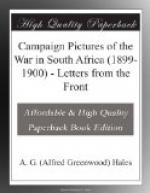I saw him again—under silk this time—as a gentleman rider. He was the same quiet, cool little fellow, grey-eyed, steel-lipped, stout-hearted, with “hands” that Archer might have envied. He rode at his fences that day as the Australian amateurs can ride, with a rip and a rattle, with the long, loose leg, the hands well down, and head up and back, and “Over or Through” was his motto. I did not know him to speak to in those old days. We were to shake hands under peculiar circumstances away in a foreign land, in a foreign hospital, both of us prisoners of war, both of us wounded. That was where and how I spoke to little Dowling, lieutenant in the First Australian Horse, as game a sample of humanity as ever threw leg over saddle or loosed a rifle at a foe. He came to my bedside the morning after I entered the hospital, and standing over me with a green shade over one eye, and one hand in a sling, said laconically:
“Australian ain’t you?”
“Yes, by gad, and I know you.” He reached out his left hand, and placed it in mine.
“Been ’stopping one’?” he remarked.
“Only a graze, thank God,” I replied.
Then the matron and the German doctor, as fine a gentleman as ever drew breath, came along to have a look at me, and he was turned out; but we chummed, as Australians have a knack of doing in time of trouble, and I tried hard to get him to talk of his adventures, but he was a mummy on that subject. He would not yarn about his own doings on the fateful day when he was laid out, though he was eloquent enough concerning the doings of his comrades. All I could get out of him in regard to his own part in the fray was that his men and he had been ambushed, and that he had “stopped one” with his head, and one with his hand, and another with his leg, his horse had been killed, and he knew mighty little more about it until he found himself in the hands of the Boers, who had treated him well and kindly. I asked the matron about his wounds, and she told me that a bullet had entered the corner of his right eye, coming out by the right ear, ruining the sight for ever. Another had carried away his right thumb, and a couple had passed through his right leg, one just below the groin, another ’just above the knee. That was what he modestly termed “stopping a few.”




